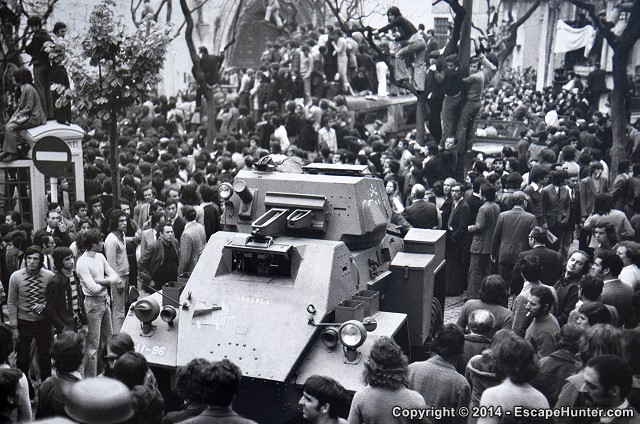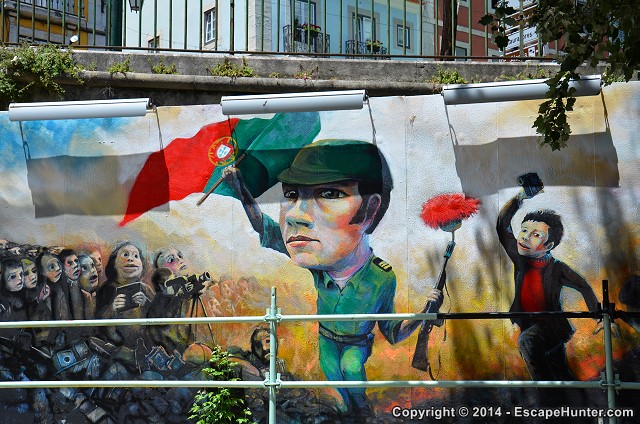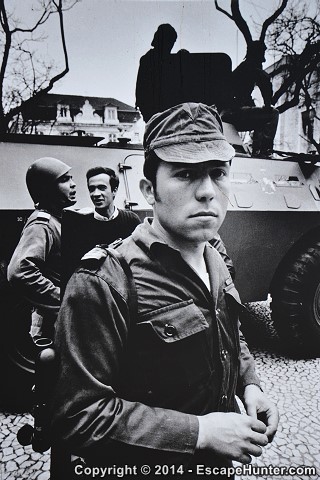HomeStream
News & more!Escapes
My trip reviewsGallery
My travel photosPlanning
Trip planningGuides
Destination guides
My Escapes  Portugal
Portugal  Another Lovely Trip to Portugal!
Another Lovely Trip to Portugal!  Lisbon
Lisbon  Dipping Into Lisbon
Dipping Into Lisbon  Remembering the Carnation [...]
Remembering the Carnation [...]
Remembering the Carnation Revolution
Portugal's Carnation Revolution marked the country's transit from the authoritarian Estado Novo regime to democracy.
Lisbon was full of commemorative plaques, posters and other elements that reminded people of what happened on April 25th, 1974.
On April 25th each year, the Portuguese celebrate the so-called Carnation Revolution - or, Revolução dos Cravos in Portuguese.
The military coup organized by the Armed Forces Movement (MFA), coupled with strong civil resistance has lead to the fall of the Estado Novo dictatorial regime without a using violence.

View Photo Gallery for more travel photos
Eventually, the fall of the authoritarian regime has lead to Portugal withdrawing from its African colonies and also from East Timor.
Today, April 25 is a national holiday in Portugal - but it is not the National Day of Portugal (which is held on June 10th).
Salgueiro Maia, seen on the photo on the left, was a military officer who had made a significant contribution to the revolution.
Therefore, he is regarded as a hero of those events.
The revolution was essentially a military coup, through which Portugal became a democracy.
This might sound quite unusual, because the military coups most often put an end democracy, settling dictators in.
Although the revolutionaries achieved their goals without using violence, the dictatorial regime's security service did kill 4 people.
Perhaps the most notable monument named to the revolution's memory is the 25 de Abril Bridge - the gigantic rusty red-coloured steel bridge spans across the wide River Tejo.
Ironically, the bridge was built during the Estado Novo regime and was initially named António de Oliveira Salazar (the prime minister and key figure of the dictatorial regime).
Nevertheless, I could not omit mentioning the Carnation Revolution, as I kept bumping into artistic representations, posters reminding people of it, in various parts of Lisbon.
The black and white photos seen here were on street posters...
But while I was strolling on Lisbon's intricate urban arteries, I encountered street art dedicated to the event.
The most memorable creation worth mentioning is the one below...

Street art dedicated to the Carnation Revolution
View Photo Gallery for more travel photos

About the Author:
Escape Hunter, the young solo traveler in his early 30's explores the World driven by curiosity, thirst for adventure, deep passion for beauty, love for freedom and diversity.
With a nuanced, even humorous approach to travel, an obsession for art and design, Escape Hunter prefers to travel slowly, in order to learn and "soak up" the local atmosphere...
Comments

As "Escape Hunter" - the curious incognito traveler with an insatiable drive to explore, I embark on slow and deep travels around
our beautiful World.
Join me and I will show you exciting destinations
"from within", through my
"escape" trips!

Travel Slang Dictionary
Guide to my personal travel slang vocabulary, which seasons my content...







The military was on the side of the population. No-one got hurt.